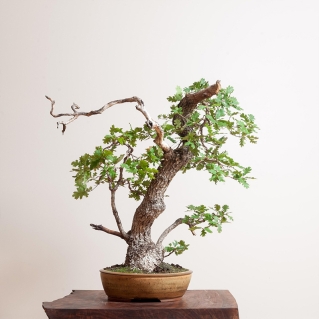
Bonsai Tree Care
Every bonsai tree can thrive in its containerized environment with the proper horticultural techniques and aesthetics. Our species care pages offer fundamental guidance to help you excel, keep your trees vibrant, and advance your bonsai skills.

Broadleaf Deciduous Species
Deciduous trees, with their annual leaf changes, offer a captivating display of nature's cyclical transformation. From lush canopies in spring and summer to vibrant fall colors, they transition to intricate bare branches in winter. These trees play vital roles in ecosystems, contributing to oxygen production, wildlife habitat, and soil health. Deciduous bonsai trees symbolize nature's resilience and cyclic beauty and exemplify the remarkable diversity and vivid representation of nature's ongoing life cycle.
Related Tree Species
Related Tree Species

Pine Species
Pines, the oldest trees on Earth, are iconic for their needles, rugged bark, and towering stature. Some surpass 150 feet, with the champion, ponderosa pine in Southern Oregon, astonishingly reaching 268 feet. With 800+ species, they dominate conifer families, mainly in the northern hemisphere. These ancient giants serve as apex species, sustaining entire ecosystems and the forests they inhabit. Pines play a pivotal role in shaping both the essential aesthetics and horticulture of the bonsai art form.
Related Tree Species
Related Tree Species

Elongating Species
Elongating species give rise to the Earth's largest trees, spanning from the majestic coastal redwoods along the Pacific coast to the graceful bald cypresses in the southeastern United States, as well as the various alpine and coastal varieties. This grouping of trees, both hardy and delicate, holds a unique power to convey the essence of the wild and ecosystems across the globe. Within the realm of bonsai, elongating species represent the most diverse and extensive category, with each species requiring nuanced care and handling.
Related Tree Species
Related Tree Species

Broadleaf Evergreen Species
Broadleaf evergreens, despite their remarkable durability, remain one of the most overlooked and under-appreciated categories of trees in native ecosystems. They thrive in diverse environments, from the tropical buttonwoods in the Florida Keys to the venerable mountain mahogany trees within the ancient bristlecone groves. These broadleaf evergreens encompass some of Earth's most varied ecosystems. In the realm of bonsai, they have yet to receive the exploration and appreciation that Mirai has dedicated to this fascinating bonsai genre.
Related Tree Species
Related Tree Species

Tropical Species
Tropical species possess a remarkable ability to thrive in the face of intense heat, humidity, sunlight, and climatic challenges within their expansive global ecosystems. As temperatures continue to rise, comprehending the broadleaf nature of tropicals and mastering their cultivation as bonsai opens up a captivating avenue for embracing this exceptionally diverse and accommodating genre. Whether you're interested in indoor or outdoor bonsai care and creation, exploring tropicals offers a unique and rewarding opportunity.
Related Tree Species
Related Tree Species

Juniper Species
Juniperus, a diverse evergreen conifer genus, thrives in varied environments, from highlands to lowlands, wet to arid, and hot to cold regions. Their strength lies in their foliage, which nourishes an extensive root network and vascular system. Juniper foliage varies, from scale-like to needle-like leaves, depending on the species and growth stage. Juniper bonsai are categorized into three subgenres: mounding, running, and needle junipers, each representing various species from around the world.




























